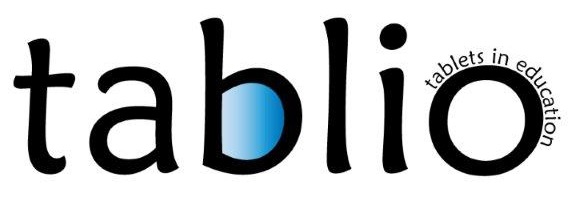Istituto Superiore "Duca Abruzzi - Libero Grassi"
Introduction
The second Teacher Design Team (TDT) has been organized at the Istituto Superiore “Duca Abruzzi-Libero Grassi”, placed in Palermo. The school begins its institutional journey on 1st September 2013, following the sizing of the Institute Surveyor and Tourism "Duca Abruzzi" and the Commercial Technical Institute "Libero Grassi ".
Currently the school is divided into two buildings:
- the "Duca Abruzzi" located in via Fazio 1;
- the "Libero Grassi", located in Viale del Fante 70/c.
Based on the Reorganization of Technical Institutes and High Schools (DPR No. 88 and 89 of March 15th 2010) the Institute has activated the following fields of study:
- Scientific high school (Traditional address; Applied Sciences address),
- Technical address - Administration, Finance and Marketing,
- Tourism,
- Technical address - Construction, Environment and Territory.
The main goal of the school is to train people who:
- are open to the cultural and economic reality in which we live, ready and competent to intervene on it and contribute concretely to its development;
- are aware of the European dimension of their cultural growth process and social skills and have the skills to access all development opportunities personal and professional at international level;
- have built a mental attitude mutual aid, solidarity, integration, mutual understanding, respect, tolerance and dialogue.
The school, therefore, offers a context in which learning and learning needs can be answered, inspired from the principles of inclusive education.
Attention to the individual that characterizes the didactic and training approach of our Institute is essential for students with disabilities, with disorders specific learning needs or with special educational needs.
The Teacher Design Team (TDT) work
The TDT was made up of:
- 1 teacher of Science
- 1 teacher of Mathematics (expert in digital didactics and e-learning)
- 1 teacher of History and Literature
All the TDT members are working in High secondary School and they involved the same students of the 4B LS-Scientific High School class, in which they intervened, starting from their learning and inclusion needs/problems.
The group collaborated with TABLIO project and CESIE starting from 2017 and for the school year 2018-2019 (from September to December 2018).
The first meeting with the group has been focused on analysing the challenges that teachers wanted to address in their daily work in class. The starting point has been the analysis of the major difficulties they meet in their teaching and which difficulties have students in following the lessons. The reflection started from the class contexts and has been focused on Mathematics, Science, Economics and Valuation as the teachers involved in the TDT are teaching these subjects.
Teachers pointed out that the first experiments of lessons using software online or app have been successful, and students were more motivated in studying that subjects (e.g. Chemistry). Teachers wanted to develop the usage of tablet (e.g., through new Apps and software online) and to develop tools to evaluate progress made by student.
The group identified the following challenges:
-Inclusion of a foreign student with linguistic obstacles (oral production, written production, comprehension) and relationship problems.
-Inclusion of a student with a difficult family background and learning obstacles.
-Need to stress on group-class cohesion.
-Need to involve students that are lacking of constructive learning methodologies.
- Evaluation of the class results using tablets and ICT tools.
Some remarks from teachers’ experience were:
- Students need alternative ways to learn mathematics, literature, history and science because it will allow them to be more motivated and learn in an easier way.
- Students with linguistic and socio-cultural problems need a learning support because it will allow them to follow lessons and be included with the rest of the class.
- Teachers need to test new approaches and tools in class with tablet in order to increase students’ participation and achieve better results.
According to the context analysis conducted by the teachers and the identified challenges, the TDT started working in class with 20 students (7 girls and 13 boys) attending the 4B LS-Scientific High School class. The class group is, on the whole, compact and close-knit, interested in the didactical activities and supported by a good method of study. Participation in the various activities is adequate and does not require particular recalls. There are no extreme disciplinary problems, but emerges the need to consolidate the method of study that, for some students, is still mnemonic and not very autonomous. One foreign student presents some linguistic problems in terms of comprehension and inclusion in class. The aims were:
- Improve students’ motivation in learning mathematics, literature, history and science.
- Actively involve the student with linguistic obstacles in regular lessons.
- Develop an atmosphere of cooperation among students.
- Create a stronger cohesion.
- Establish a friendly competition among students.
- Improve learning motivation.
Some first ideas on how to address design challenges have been addressed and teachers came up with some possible resources and solutions for the design phase:
- To work with students through laboratory methodology/approaches/techniques.
- To improve active participation in class and at home through tutoring and mentoring support.
- To facilitate students’ learning development through ICT resources (tablet, online platforms -> e.g. Edmodo weschool, online software -> e.g. Socrative and apps ->e.g. Kahoot!, Quizlet, Cmap).
The TDT group met the Project Manager on September 2018 for a second meeting after the beginning of the school year. During this meeting, they were invited to think about possible solutions for the identified challenges and to share the outcomes of the reflections on possible solutions.
The third meeting has been organized a month after the second one and teachers during that period have been invited to start developing activities in class with students combining innovative existing technology on tablet and instructional approaches into new learning scenarios and accompanying learning materials.
From November 2018 the TDT group started the implementation of the activities with the students in classroom, within the 4 following pedagogical arrangements.
1st pedagogical arrangement: New approaches to Science
Kahoot!
Through training in groups of 4/5 people, students start preparing different Kahoot! on the chemical nomenclature and they share them with the rest of the class, on order to assess different levels of complexity.
Moreover, through this platform, the students had the chance to do the quizzes created by the teacher with Kahoot!.
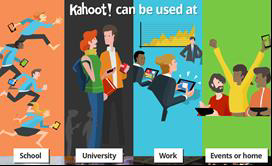
Pic.1: Kahoot! platform
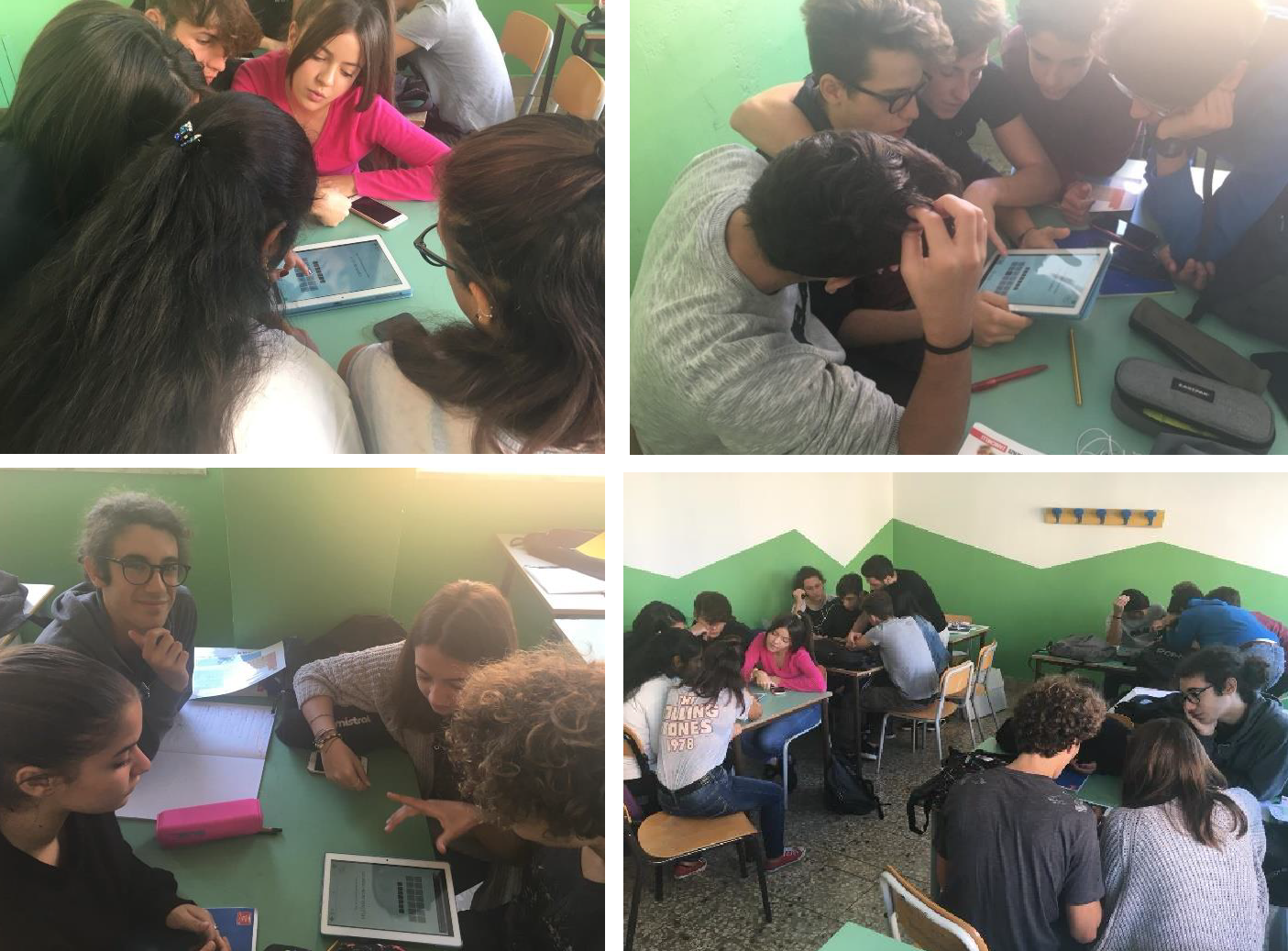
Pictures 2 – 5: Students working with tablets in class
Specific Apps
“Acidi, ioni e sali inorganici” (Acids, ions and inorganic salts)
The app named “Acidi, ioni e sali inorganici” (Acids, ions and inorganic salts) has been used for the review of the names and formulas of all of the most important inorganic acids, polyatomic ions and the relative salts. After the installation of the app on the tablets supplied to the school by CESIE, it has been used for a quick review through group work.
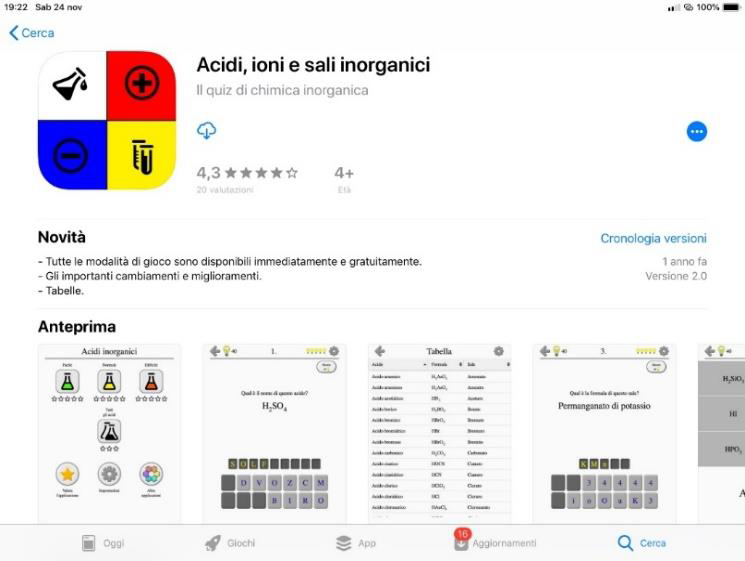
Pic 6: The app "Acidi, ioni e sali inorganici" (Acids, ions and inorganic salts).
Socrative
Socrative is a web platform that allows to create online quizzes, tests and surveys.
It can be used on any tablet, Smartphone, computer and laptop. The teacher accesses Socrative through his/her account, creates the tests and gives it to the students. From their devices, the students log in with their account and do the test prepared by the teacher. The teacher can follow the ongoing work of the students on his/her device and get the results in real time, and in graphical form. You can find different kind of questions: multiple choices questions, true-or-false questions or with short open answers.
The test was prepared by the teacher with the support of different images. This function is very useful because most of the test involved the recognition of animal tissues and their description: this action requires clear and colorful images.
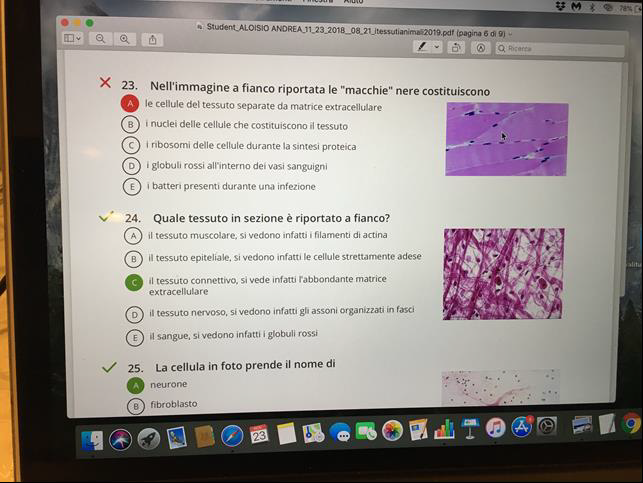
Pic 7: Exemple of a test created with "Socrative"
Students had the possibility to use their smartphones, tablets or their PCs. The timing of the test was established by the teacher who could have decided to stop it at any time. The students were always very concentrated, more than when they do traditional tests. They did not tend to distract because the questions can be given in random order as well as the answers. At the end of the test, for each student, the software processed a pdf file with the automatically correct questions and answers.
For the questions with open answers, the teacher proceeded with the traditional correction.
Then, the final data are reported by the teacher on a spreadsheet to get the students’ marks. At the end, all the material is sent to the students through the virtual classroom and after having uploaded their marks on the school's platform, ARGO.
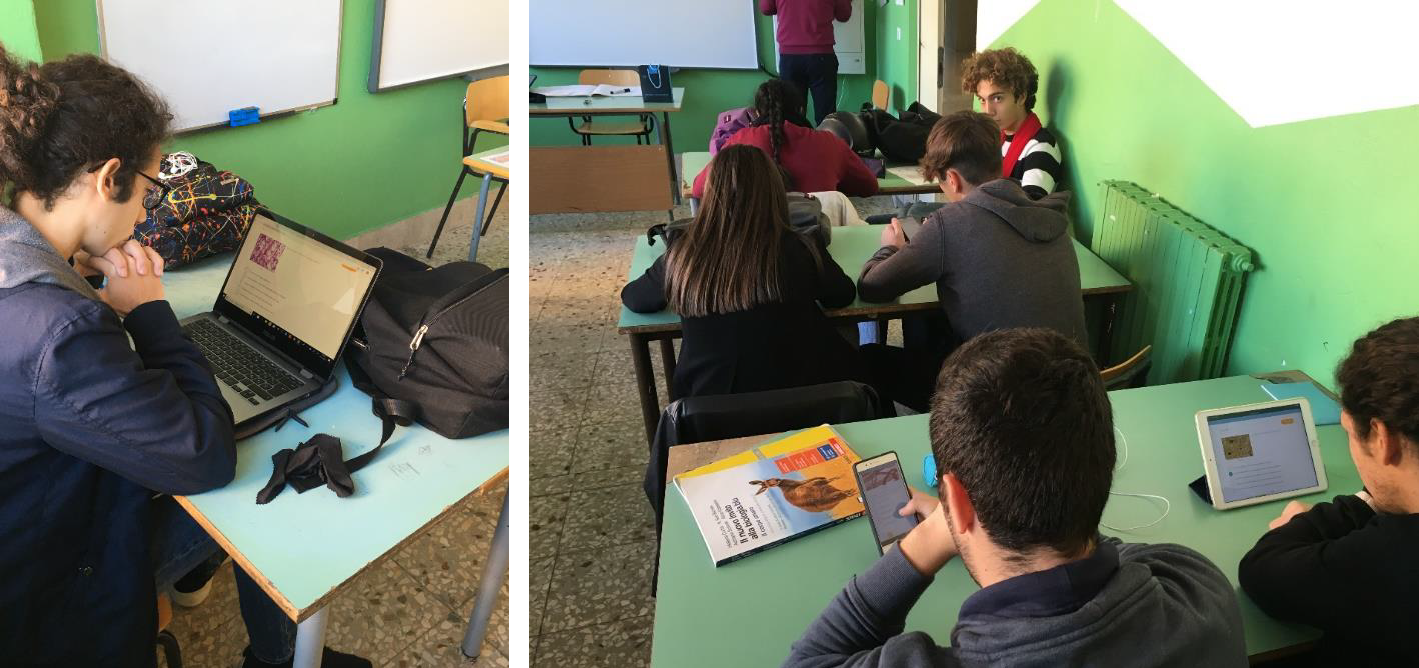
Pictures 8 -9: Students work with "Socrative"
EDMODO
Edmodo is a social network designed to interact with the class outside the school walls. Called the “School’s FACEBOOK”, it offers the teacher the possibility to create tests for the class, to post video-tutorial or general information.
Through this platform, the teacher creates a "group" (which usually has the name of the class) and invites the students through a shared a password. Within the group, the communication can be “many-to-many” (the teacher with everybody or a student with everybody) or “discreet”, between teacher and student.
The students already knew the platform so the teacher created a sub-group named TABLIO.
The Edmodo platform was used for the exchange of educational material. In this case, through a link students can access to an online test on the nomenclature of inorganic compounds, or to a solved and commented exercises. Also, the platform was useful for the somministration of short training tests to test the students’ educational improvements.
Specifically, the test was created with some exercises related to the calculation of oxidation numbers. The students’ answers were sent to the teacher through the EDMODO platform. Then, the teacher sent the correct tests with some comments to the students, whom could reply through a chat. At the end, the teacher created individual assessments.
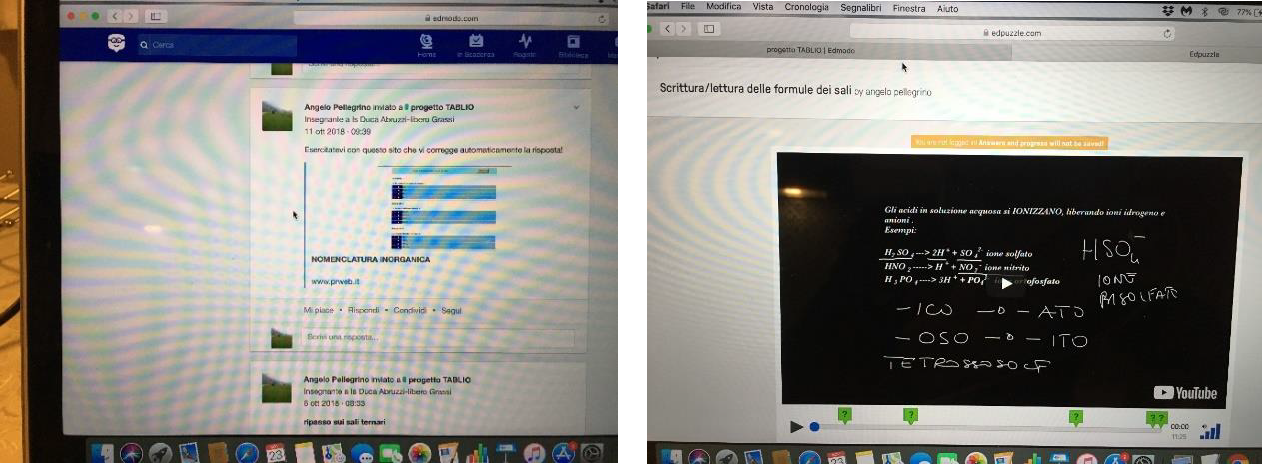
Pictures 10-11: The social network of the classroom, EDMODO.
EDPUZZLE
EdPuzzle is a free platform that allows to create multimedia lessons using videos as learning tools. With Edpuzzle you can search and select a video on multiple specialized websites (YouTube, Vimeo, Khan Academy, National Geographic ...) or upload your own, cut the portion you are interested in, add an audio, insert a voice annotation upon a specific part of the video, to propose different kind of quizzes in some points of the video and to give the edited video to the students.
For this class, was chosen a video from YouTube where was explained the nomenclature of the ternary salts. Through EdPuzzle, the teacher created short questions to put in some points of the video, indicated with green placeholders.
At the end, the students had the opportunity to evaluate their answers and to review them watching the video. The link to the video was shared with the class using the Edmodo platform.
2nd pedagogical arrangement: The project “Billy e la scuola” (Billy and the School)
The project aimed at creating a virtual exchange of literature and reading knowledge between the Facebook group “Billy, il vizio di leggere” (formed by readers) and the students of the class 4B LS.
Starting from the suggestion of a book, the group members and students have read the same text for a month. During this period, they had four online meetings in which they could talk together trying to come up with useful elements for the understanding of the plot. The students were able to interact with a group of readers.
The books have been suggested by the members of the Facebook group and selected by the students.
At the end of the project, students had the opportunity to write a small article about their experience, which has been published into the local journal “La Repubblica-Palermo”.
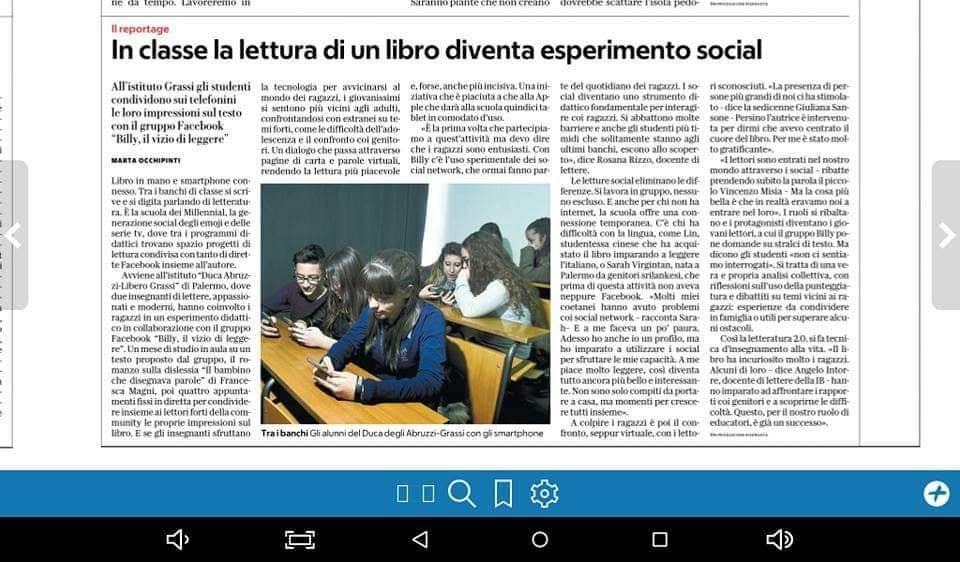
Pic 12: The article about “Billy e la scuola” written by the students of the 4BLS class.
The selected book of the project was “Il bambino che disegnava parole”, a romance about dyslexia. Students had the possibility to communicate both with the Facebook group members and with the author of the book.
This kind of interactive activity was very useful and stimulating for students who could share their opinions about the thematic of the book with adults. On the other hand, adults had the chance to think about their approach to the thematic and to understand better students’ needs.
Thanks to this project, the use of smartphone and social networks has been promoted during regular lessons in class. Paper and virtual words were mixed with the aim to promote the social networks as didactical tools for the involvement and inclusion of all the students. They worked in mixed groups to overcome any kind of barrier (linguistic, mental, etc.).
The teacher is trying to continue this learning approach, organising virtual meeting on Skype with students and journalists/authors.
Liber Liber
In addition to this activity, the class has been studying history (in particular history of law) using the platform Liber Liber (www.liberliber.it) where students and teachers can download Books, Audiobooks, Music and Videos.
The members of the class have a mini library in their smartphones, where they have been reading and studying different books, Classics, texts and resources.
Some materials read: Dei delitti e delle pene- Cesare Beccaria; Viaggio in Italia- W. Goethe; Universal Declaration of Human Rights; Constitutions.
3rd pedagogical arrangement: The project “Nei panni dell'altro”
The project "Nei panni dell’altro" saw the participation of the students in a theatrical workshop run by the director Preziosa Salatino. The methodology used by the workshop called "the theater of the oppressed" has a strong pedagogical value.
The students of the class 4BLS used their smartphones to interview professors, students and family members about the immigration topic. Once in the classroom, in a circle time setting, they placed a speaker in the middle of the circle, with all their devices connected via Bluetooth. Everyone has listened to the interviews recorded and at the end they opened up a debate about the results.
The mentioned records have been shared on a WhatsApp group from where the students together with the teacher will select the soundtrack for a theatrical show that will be broadcast at school in February.

Pictures 13-14: Students work within the project "Nei panni dell'altro"
4th pedagogical arrangement: The project “MOODLE”
The project involves the use of MOODLE, an e-learning platform built up by the Institute, which can be activated from the Institute's homepage or directly on the website of the teacher. The platform aims at:
- the review of the topics managed in classroom for all the students
- the study of the topics treated in class for absent pupils
- Training tests
- “Flipped classroom” activities
The pictures below show an example of this last activity. Through their devices (tablet or smartphone), the students analyse the materials prepared by the teacher in the classroom or at home and they take notes about their doubts. Once in the classroom, the teacher clarifies and does exercises, individually and/or in groups with the students.
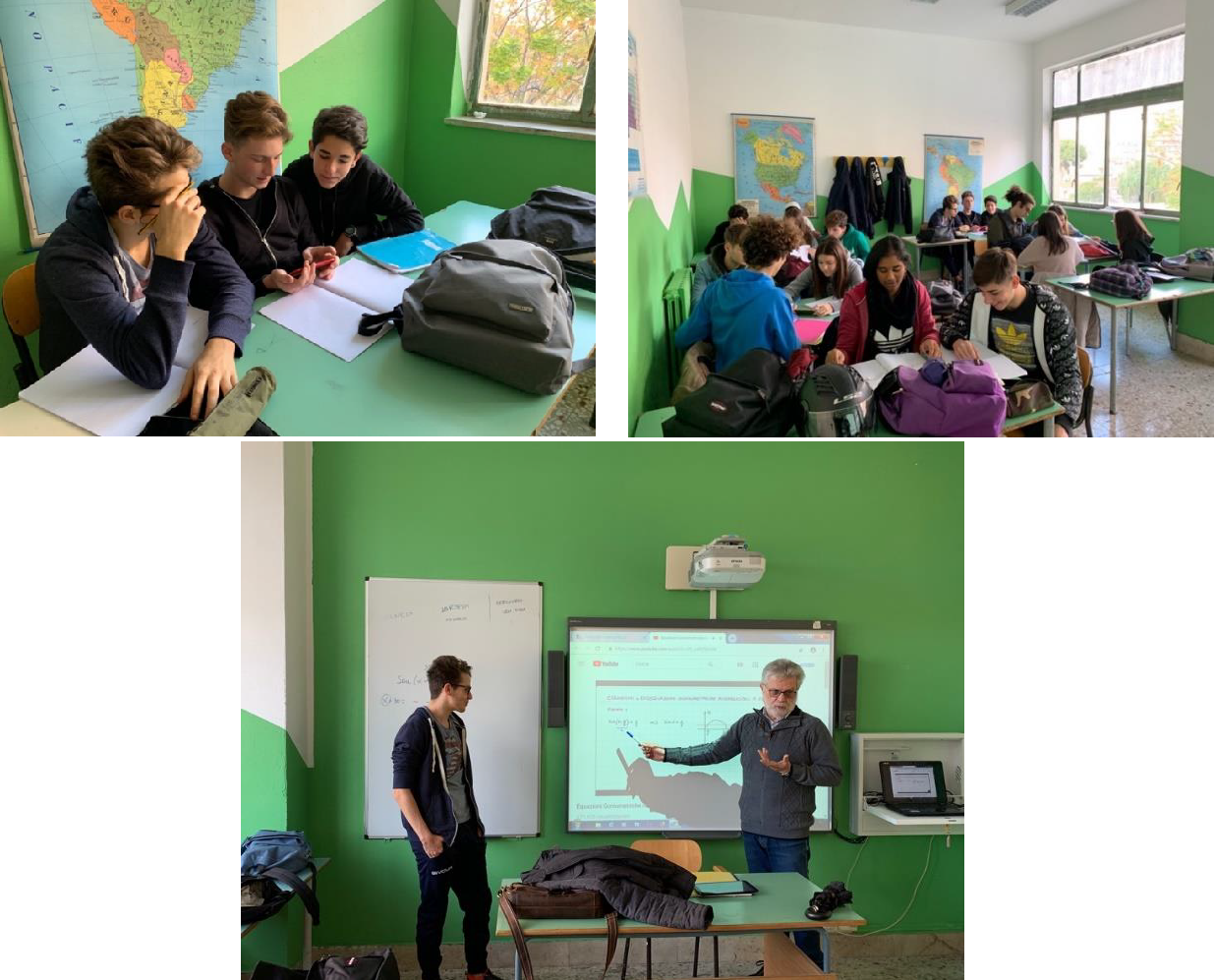
Pictures 15-17: The project MOODLE
Methodology and group strategies
Students mainly worked in groups collaborating actively in classes. The formation of the groups was based on the kind of activities, subjects, students’ inclinations and always guaranteed cooperation and socialization among students because the groups have been mixed several times.
Timing
The class has been involved in the activities of the project from September 2018 until December 2018, during the first trimester of the school year 2018-2019.
Evaluation methodology
- Individual (1-1) online revision between teacher and student.
- Collective revision in class (the teacher shows all the correct exercises to the class through the interactive whiteboard).
Conclusions
The work of the TDT followed the ADDIE-method in an interactive process where Analysis, Design, Development, Implementation and Evaluation (optimisation of the design) go hand-in-hand. Each new pedagogical arrangement has been designed following the design principles, described following the design-templates and evaluated following the evaluation criteria. Teachers were also interviewed, documents and tools were analysed, class observations were done and video reports were made. At the beginning of the TDT work have been set with teachers clear goals and objectives. The monitoring process covered all the implementing period (from analysis to evaluation) and at the end teachers were able to demonstrate that all the fixed objectives and expected results were reached. Indeed, the activities realized in class have been very useful for both the TDT and students.
The TDT reached the following results:
- Increased use of tablet and digital devices in class.
- Developed tools to evaluate progress made by students.
- Involvement of students with linguistic and socio-cultural obstacles and/or learning difficulties in regular lessons.
- Alternative teaching and learning methodologies used in class.
- Improved students’ motivation and participation in class.
- Virtual classes/apps tested and used in class.
- Learning improvement on scientific subjects through the use of the apps as: Kahoot!, EDMODO and Socrative.
- Improvement in text comprehension through the participation of the students at the project "Billy e la scuola” (Billy and the school)
- Improvement in the study of history and history of law through the Liber Liber platform.
At the end of the school year, teachers and students filled out an evaluation form, provided by the TABLIO team, in order to investigate the effect/impact of the activities as well as teachers’ and students’ satisfaction at different levels. The TDT underlines the great result of the activities in terms of differentiation and inclusion in class.
According to the responses of the questionnaires made by the students, they were satisfied with the activities performed with the tablet and other devices in the classroom, and they believe that this project has brought good results for their educational path.
Furthermore, this project has implemented the inclusion of those students with learning difficulties and encouraged greater collaboration among classmates. The activity that was most followed and appreciated from the students was the use of "Kahoot!".
Generally, they showed a great interest in studying with tablets and differentiating their learning process at school.
